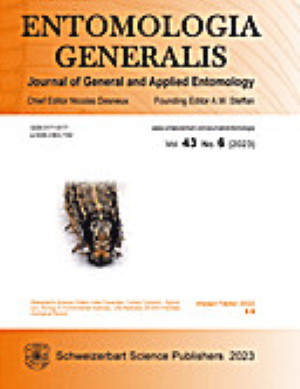Cadmium triggers hormesis in rice moth Corcyra cephalonica but different effects on two Trichogramma egg parasitoids
IF 4.6
1区 农林科学
Q1 ENTOMOLOGY
引用次数: 0
Abstract
Increasing awareness of cadmium (Cd) pollution in agroecosystems has highlighted the need for a better understanding of the cascading effects heavy metals on the fitness of herbivores and their natural enemies, as well as the potential impact on the efficacy of integrated pest management (IPM). In this study, we assessed the bottom-up effects mediated by Cd on two important egg parasitoids, Trichogramma japonicum and T. dendrolimi via their factitious host, the rice moth Corcyra cephalonica. Results showed that the bottom-up effects mediated by Cd are complex. Cd exposure at 20 mg/kg in artificial diets of rice moth larvae enhanced the weight of eggs laid once they have reached adulthood, increased the proportion of females produced, and stimulated reproduction, thus suggesting a hormesis response. A stimulation effect on T. dendrolimi fitness was also found (when developing from contaminated rice moth eggs), but T. japonicum instead had a reduced fitness. In addition, unexposed adult parasitoids (reared from uncontaminated hosts) were not able to discriminate between uncontaminated or contaminated eggs (produced by rice moths reared on Cd-diet). Our results show that Cd contamination should not interfere with the effectiveness of inundative releases of T. japonicum, but the capacity of the subsequent F1 generation of parasitoids in controlling pest populations could be affected by Cd contamination. This suggests that inundative releases should be favored over inoculative releases in Cd-contaminated sites, and mixed-species releases of Trichogramma could increase the cost effectiveness of pest biological control.镉会诱发稻飞虱的激素作用,但对两种蓟马卵寄生虫的影响不同
人们对农业生态系统中镉(Cd)污染的认识不断提高,这突出表明有必要更好地了解重金属对食草动物及其天敌的适应性产生的连锁效应,以及对害虫综合防治(IPM)效果的潜在影响。在这项研究中,我们评估了镉通过其寄主稻飞虱(Corcyra cephalonica)对两种重要的卵寄生虫--日本蓟马(Trichogramma japonicum)和蓟马(T. dendrolimi)的自下而上的影响。结果表明,镉介导的自下而上的影响是复杂的。在稻飞虱幼虫的人工日粮中摄入 20 毫克/千克的镉可提高其成年后产卵的重量,增加雌虫的比例,并刺激其繁殖,因此表明这是一种激素作用反应。也发现了对 T. dendrolimi 适应性的刺激作用(当从受污染的稻蛾卵中发育时),但 T. japonicum 的适应性反而降低了。此外,未接触镉的寄生虫成虫(从未受损伤的寄主处饲养)无法区分未受损伤或受污染的卵(由镉饮食饲养的稻蛾产卵)。我们的研究结果表明,镉污染不会影响日本蓟马淹没释放的效果,但随后的 F1 代寄生虫控制害虫种群的能力可能会受到镉污染的影响。这表明,在镉污染地区,淹没释放比接种释放更受青睐,而且混种释放日本蓟马可提高害虫生物防治的成本效益。
本文章由计算机程序翻译,如有差异,请以英文原文为准。
求助全文
约1分钟内获得全文
求助全文
来源期刊

Entomologia Generalis
生物-昆虫学
CiteScore
7.10
自引率
18.80%
发文量
72
审稿时长
>12 weeks
期刊介绍:
Its scope covers all aspects of basic and applied research dealing with insects and more broadly with arthropods inhabiting wild, agricultural and/or urban habitats. The journal also considers research integrating various disciplines and issues within the broad field of entomology and ecology.
Entomologia Generalis publishes high quality research articles on advances in knowledge on the ecology and biology of arthropods, as well as on their importance for key ecosystems services, e.g. as biological control and pollination. The journal devotes special attention to contributions providing significant advances (i) on the fundamental knowledge and on sustainable control strategies of arthropod pests (including of stored products) and vectors of diseases, (ii) on the biology and ecology of beneficial arthropods, (iii) on the spread and impact of invasive pests, and (iv) on potential side effects of pest management methods.
Entomologia Generalis welcomes review articles on significant developments in the field of entomology. These are usually invited by the editorial board, but proposals may be sent to the Editor-in-Chief for preliminary assessment by the editorial board before formal submission to the journal. The journal also considers comments on papers published in Entomologia Generalis, as well as short notes on topics that are of broader interest.
 求助内容:
求助内容: 应助结果提醒方式:
应助结果提醒方式:


